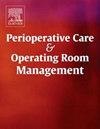Characterization of surgical flow disruptions in orthopedic surgery using a human factors approach
IF 1
Q2 Nursing
Perioperative Care and Operating Room Management
Pub Date : 2025-04-05
DOI:10.1016/j.pcorm.2025.100488
引用次数: 0
Abstract
Background
Efficient and safe perioperative care is critical to optimizing surgical outcomes and reducing preventable errors. Orthopedic procedures, ranging from minimally invasive techniques to complex surgeries, place significant cognitive and physical demands on surgical teams. Disruptions in workflow can compromise efficiency, coordination, and patient safety. This study aimed to systematically identify and categorize surgical flow disruptions to inform quality improvement efforts.
Method
Forty orthopedic surgeries were observed. A human factors taxonomy was used to classify disruptions, and descriptive statistical analysis was applied.
Result
Of the 2343 total disruptions observed, Interruptions (46.39 %) were the most frequent, followed by communication failures (33.25 %), coordination challenges (13.19 %), layout inefficiencies (5.25 %), equipment issues (1.20 %), and usability concerns (0.73 %). This translated into one disruption every 3.7 min for the 40 surgeries.
Conclusions
Addressing surgical flow disruptions proactively can enhance perioperative efficiency, safety, and team coordination. This study presents system vulnerabilities, enabling the possibility of shifting the focus from reactive error analysis to proactive mitigation strategies.
用人为因素方法分析骨科手术中手术血流中断的特征
背景:有效和安全的围手术期护理是优化手术效果和减少可预防错误的关键。骨科手术,从微创技术到复杂的手术,对外科团队的认知和身体都有很大的要求。工作流程中的中断会影响效率、协调和患者安全。本研究旨在系统地识别和分类手术血流中断,为质量改进工作提供信息。方法对40例骨科手术进行观察。采用人为因素分类法对干扰进行分类,并采用描述性统计分析。结果在观察到的2343次中断中,中断(46.39%)是最常见的,其次是通信故障(33.25%)、协调挑战(13.19%)、布局效率低下(5.25%)、设备问题(1.20%)和可用性问题(0.73%)。这意味着在40次手术中,每3.7分钟就有一次中断。结论主动应对手术流程中断可提高围手术期效率、安全性和团队协作能力。本研究提出了系统漏洞,使重点从被动错误分析转移到主动缓解策略的可能性。
本文章由计算机程序翻译,如有差异,请以英文原文为准。
求助全文
约1分钟内获得全文
求助全文
来源期刊

Perioperative Care and Operating Room Management
Nursing-Medical and Surgical Nursing
CiteScore
1.30
自引率
0.00%
发文量
52
审稿时长
56 days
期刊介绍:
The objective of this new online journal is to serve as a multidisciplinary, peer-reviewed source of information related to the administrative, economic, operational, safety, and quality aspects of the ambulatory and in-patient operating room and interventional procedural processes. The journal will provide high-quality information and research findings on operational and system-based approaches to ensure safe, coordinated, and high-value periprocedural care. With the current focus on value in health care it is essential that there is a venue for researchers to publish articles on quality improvement process initiatives, process flow modeling, information management, efficient design, cost improvement, use of novel technologies, and management.
 求助内容:
求助内容: 应助结果提醒方式:
应助结果提醒方式:


